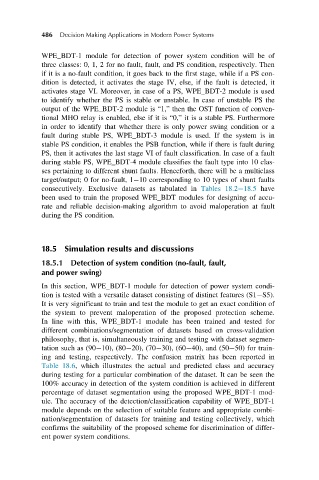Page 527 - Decision Making Applications in Modern Power Systems
P. 527
486 Decision Making Applications in Modern Power Systems
WPE_BDT-1 module for detection of power system condition will be of
three classes: 0, 1, 2 for no fault, fault, and PS condition, respectively. Then
if it is a no-fault condition, it goes back to the first stage, while if a PS con-
dition is detected, it activates the stage IV, else, if the fault is detected, it
activates stage VI. Moreover, in case of a PS, WPE_BDT-2 module is used
to identify whether the PS is stable or unstable. In case of unstable PS the
output of the WPE_BDT-2 module is “1,” then the OST function of conven-
tional MHO relay is enabled, else if it is “0,” it is a stable PS. Furthermore
in order to identify that whether there is only power swing condition or a
fault during stable PS, WPE_BDT-3 module is used. If the system is in
stable PS condition, it enables the PSB function, while if there is fault during
PS, then it activates the last stage VI of fault classification. In case of a fault
during stable PS, WPE_BDT-4 module classifies the fault type into 10 clas-
ses pertaining to different shunt faults. Henceforth, there will be a multiclass
target/output; 0 for no-fault, 1 10 corresponding to 10 types of shunt faults
consecutively. Exclusive datasets as tabulated in Tables 18.2 18.5 have
been used to train the proposed WPE_BDT modules for designing of accu-
rate and reliable decision-making algorithm to avoid maloperation at fault
during the PS condition.
18.5 Simulation results and discussions
18.5.1 Detection of system condition (no-fault, fault,
and power swing)
In this section, WPE_BDT-1 module for detection of power system condi-
tion is tested with a versatile dataset consisting of distinct features (S1 S5).
It is very significant to train and test the module to get an exact condition of
the system to prevent maloperation of the proposed protection scheme.
In line with this, WPE_BDT-1 module has been trained and tested for
different combinations/segmentation of datasets based on cross-validation
philosophy, that is, simultaneously training and testing with dataset segmen-
tation such as (90 10), (80 20), (70 30), (60 40), and (50 50) for train-
ing and testing, respectively. The confusion matrix has been reported in
Table 18.6, which illustrates the actual and predicted class and accuracy
during testing for a particular combination of the dataset. It can be seen the
100% accuracy in detection of the system condition is achieved in different
percentage of dataset segmentation using the proposed WPE_BDT-1 mod-
ule. The accuracy of the detection/classification capability of WPE_BDT-1
module depends on the selection of suitable feature and appropriate combi-
nation/segmentation of datasets for training and testing collectively, which
confirms the suitability of the proposed scheme for discrimination of differ-
ent power system conditions.

